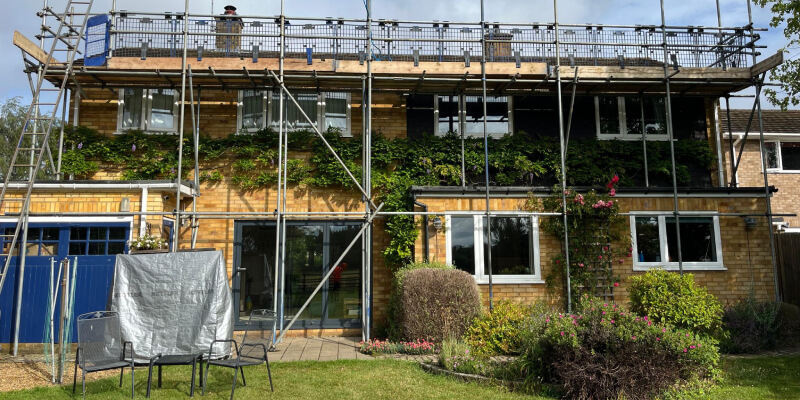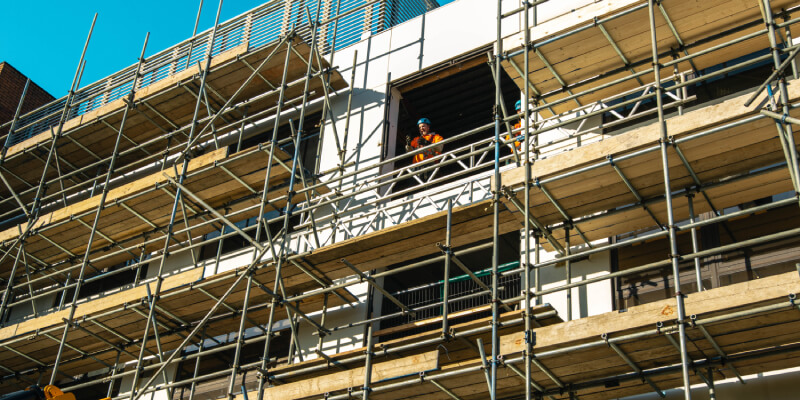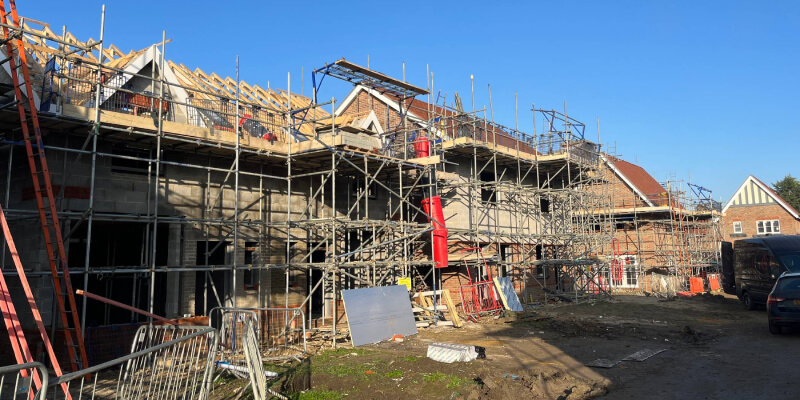If you’re considering having work done on your property, it’s worth thinking about how the construction might affect your neighbours. While your neighbours can’t stop you from erecting scaffolding on your property, the rules change if you require access to their property. In most instances, a simple, open discussion will resolve any potential issues, but when that isn’t possible, it’s important to understand your scaffolding rights. In this article, we’ll be using our decades of experience as a leading scaffolder in Milton Keynes to answer the question, ‘Can a neighbour refuse access for scaffolding?’ So, keep reading to take on your residential construction projects confidently.
Can A Neighbour Refuse Access For Scaffolding On Your Property?
Simply put, your neighbour cannot stop you from putting up scaffolding as long as it remains within the grounds of your property. If it extends beyond your boundary and into their property, you must ask permission to erect the scaffolding. They are free to deny this request, and you will need to find an alternative solution if they do. Over the last thirty years, there have been many legislative reforms regarding residential construction and your access as a homeowner. So, keep reading to understand these laws and your construction rights better.
- What Are Your Scaffolding Rights?
- Access To Neighbouring Land Act 1992
- What Is An Access Order?
- Cost Of Access Order To Neighbouring Land
- What Is The Party Wall Act?
What Are Your Scaffolding Rights?
You are free to erect scaffolding without needing planning permission as long as it is within your property’s boundaries. You can get an idea of your property’s boundaries by looking at its title plan. If the scaffolding extends beyond these boundaries, you’ll need to obtain a license from your local council to erect it – this GOV.UK tool will help you better understand your council’s application process and any associated fees.
If the scaffolding extends into your neighbour’s property, you’ll need express permission from them to access their grounds. Otherwise, you could be liable for trespassing. If your neighbour refuses access but you believe the work should be carried out to preserve the land (e.g. clearing blocked drains), you have a few legal options to take it further. These include obtaining an Access Order or a Party Wall Agreement, which we’ll look at in greater detail below.

Access To Neighbouring Land Act 1992
The legal right for one neighbour to enter another’s land to complete repairs on their property is covered by the Access to Neighbouring Land Act (ANLA) 1992. Generally, you are trespassing if you go onto your neighbour’s land without their permission. However, under the ANLA, you are free to access your neighbour’s land without their permission if it is necessary to make repairs to your property.
Despite this precedent, it’s usually in your best interest to preserve good relations with your neighbours and ask permission before entering their land. If they refuse you entry, you can seek an order from the court forcing them to give you access. The court will grant you access as long as it is for ‘basic preservation works’ to your property. Basic preservation works include:
- Maintenance, repair or renewal of a building.
- Clearance, repair or renewal of a drain, sewer, pipe or cable.
- Filling in or clearing a ditch.
- Felling, removal or replacement of a tree, hedge or other plant that is dead, diseased, insecurely rooted or which is likely to be dangerous.

What Is An Access Order?
An Access Order is granted by the courts under the ANLA, and it requires the neighbour to give access for the purpose specified in the court application. The court will consider the neighbour’s position and may decide not to grant the order if it is too onerous and overly inconveniences them.
For a successful Access Order application, the claimant will need to present evidence that the work cannot be carried out or would be substantially more difficult to carry out without access to neighbouring land. The Access Order will specify the details of the work that is to be carried out, including timescale and location. Additionally, the neighbour may be entitled to compensation, particularly if they are working on a construction project of their own. They may be awarded compensation for:
- Additional costs in managing their own rebuilding project.
- Delay to their own building project.
- The delay in their ability to monetise their investment in the building.
- Damage to their property.
- Substantial loss of privacy or other substantial inconvenience.

Cost Of Access Order To Neighbouring Land
If you are successful at court, as a defendant or claimant, for a case under the ANLA, costs will likely be awarded in your favour. To claim legal costs, the successful party will be required to initiate the detailed assessment process. This assessment takes place at the conclusion of any court case to establish the full amount of costs payable. To initiate the process, the receiving party must provide their Notice of Commencement of Detailed Assessment alongside a bill of costs. Upon receiving the notice of commencement, the paying party will have 21 days to submit any points of dispute or to make the payment.
The average cost of obtaining an Access Order to neighbouring land varies depending on several variables. However, these are the typical fees you can expect:
- Legal Fees: Recruiting the services of a solicitor can cost anywhere between £1,000 and £5,000, depending on the complexity and duration of the proceedings.
- Court Fees: The application fee for an access order with a county court typically costs between £250 to £500.
- Compensation: The applicant may be required to compensate the landowner for any inconvenience or damage caused. This amount can vary hugely depending on the circumstances.
- Surveyor Fees: If a surveyor’s report is needed, this can add another £500 to £1,500 to the total cost.
If you’re planning on applying for an Access Order, it’s advisable to budget between £5,000 and £7,000.

What Is The Party Wall Act?
The Party Wall etc. Act 1996 is designed to prevent and resolve disputes regarding party walls, party structures, boundary walls, and excavations near neighbouring buildings. That means any structure that belongs to multiple properties, e.g., the dividing wall in a terraced property. The Act gives a building owner, who wishes to carry out work to an existing party wall, additional rights beyond their common law rights. Some of the most common rights include:
- To repair a party wall.
- To raise the height of a party wall.
- To extend a party wall downwards.
- To demolish and rebuild a party wall.
If a property owner intends to carry out work like those outlined above, they must inform all adjoining owners. If work begins without having first given notice, adjoining owners can seek a court injunction or other legal action to stop the work. Adjoining owners can’t prevent someone from making changes in accordance with rights given to them by the Party Wall etc. Act 1996, but they can influence how and when the work is done.
Notice should be given to the adjoining owner at least two months before the planned starting date for work on the party wall. Notice can be verbal or written, and the adjoining owner can agree to let the work start earlier, but they are not obliged to. After they’ve received a notice, the adjoining owner can either give their consent in writing, refuse to consent to the works, or do nothing. If they have not responded within 14 days of serving the notice, a dispute is deemed to have arisen.
Where a dispute has arisen, and an agreement cannot be reached, adjoining owners will need to appoint an agreed surveyor to draw up an ‘award‘. The award will aim to resolve the dispute in a fair and practical way, and it usually includes the following:
- Outlines the work that will be carried out.
- Details about when and how the work will be carried out.
- Specifies any additional work required (e.g. to prevent damage)
- A record of the adjoining property’s condition before any work begins to attribute and make good any damage.
- Grants the surveyor access to the property while works are going on to ensure they’re in accordance with the award.
Under the Act, an adjoining owner and/or occupier must, when necessary, let in your workmen to carry out works in pursuance of the Act (but only for those works), and allow access to any surveyor appointed as part of the dispute resolution procedure.

Scaffolding With Confidence
It’s clear there’s a lot to consider when erecting scaffolding that might interfere with your neighbour’s property. Fortunately, there’s plenty of legislation in place to support homeowners’ rights to make repairs and maintain their property. It’s always best to consult with a professional before committing to any residential construction, so if you’re looking for scaffolding in Milton Keynes, get in touch with our team at Merlin Scaffolding. We’ve been providing first-class scaffolding for over twenty years, so we’re expertly placed to advise you on your scaffolding rights.
